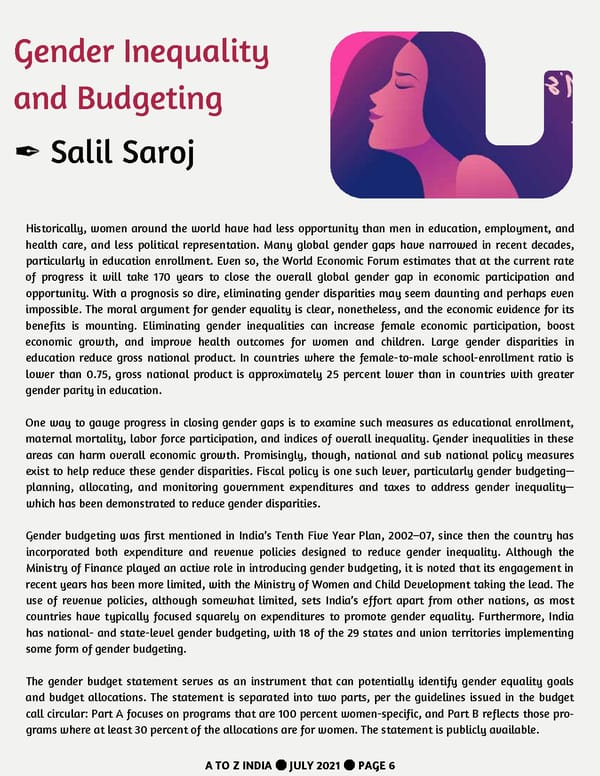Gender Inequality and Budgeting ✒ Salil Saroj Historically, women around the world have had less opportunity than men in education, employment, and health care, and less political representation. Many global gender gaps have narrowed in recent decades, particularly in education enrollment. Even so, the World Economic Forum estimates that at the current rate of progress it will take 170 years to close the overall global gender gap in economic participation and opportunity. With a prognosis so dire, eliminating gender disparities may seem daunting and perhaps even impossible. The moral argument for gender equality is clear, nonetheless, and the economic evidence for its benefits is mounting. Eliminating gender inequalities can increase female economic participation, boost economic growth, and improve health outcomes for women and children. Large gender disparities in education reduce gross national product. In countries where the female-to-male school-enrollment ratio is lower than 0.75, gross national product is approximately 25 percent lower than in countries with greater gender parity in education. One way to gauge progress in closing gender gaps is to examine such measures as educational enrollment, maternal mortality, labor force participation, and indices of overall inequality. Gender inequalities in these areas can harm overall economic growth. Promisingly, though, national and sub national policy measures exist to help reduce these gender disparities. Fiscal policy is one such lever, particularly gender budgeting— planning, allocating, and monitoring government expenditures and taxes to address gender inequality— which has been demonstrated to reduce gender disparities. Gender budgeting was first mentioned in India’s Tenth Five Year Plan, 2002–07, since then the country has incorporated both expenditure and revenue policies designed to reduce gender inequality. Although the Ministry of Finance played an active role in introducing gender budgeting, it is noted that its engagement in recent years has been more limited, with the Ministry of Women and Child Development taking the lead. The use of revenue policies, although somewhat limited, sets India’s effort apart from other nations, as most countries have typically focused squarely on expenditures to promote gender equality. Furthermore, India has national- and state-level gender budgeting, with 18 of the 29 states and union territories implementing some form of gender budgeting. The gender budget statement serves as an instrument that can potentially identify gender equality goals and budget allocations. The statement is separated into two parts, per the guidelines issued in the budget call circular: Part A focuses on programs that are 100 percent women-specific, and Part B reflects those pro‑ grams where at least 30 percent of the allocations are for women. The statement is publicly available. A TO Z INDIA ● JULY 2021 ● PAGE 6
 A TO Z INDIA - JULY 21 Page 5 Page 7
A TO Z INDIA - JULY 21 Page 5 Page 7